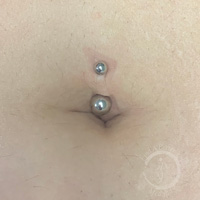Belly Button Piercing
Overview |
An overview on the safest way to get your belly button pierced. |
Price for Belly Button Piercing |
$60 + jewelry cost |
Belly Button Piercings
Body piercings are still gaining popularity. Belly button piercings are the most popular type of piercing, especially at the ages below 25. Even though 90% of parents are against them, it's important to make sure that it is done safely.

Sanitary Conditions at our Medical Spa
As a medical spa we are held to a higher standard. We also have a triple licensed physician (Dr. James Sturm D.O. DABA, FIPP) is onsite at all times. As an: anesthesiologist, pain management, and interventional pain management physician; we look at things differently than tattoo parlors. We also autoclave all of our piercings and equipment (sterilizes medical equipment).
What is a belly button ring?
A belly button ring (navel ring) is an adorning decoration for the navel, typically in a curved barbell or circular shape. Metals most popular for belly button rings include surgical steel, solid 14k gold, or titanium.
Gold or silver plated metals may break easily or cause irritation to your belly button. This is why we will only use body piercing jewelry available in our office. Please do not bring your own or ask us to use one you have already purchased.
Medical risks of a Belly Button Piercing
As a parent, this is not the first thing you think of with body piercings. You may be opposed to the idea of getting a piercing because you are concerned about the medical risks. But this is why our medical spa offers a safe and sterile place.
Can a Navel Piercing pose a dangerous risk of infection?
Yes, all piercings can. It is risky because the needles used to pierce the skin can spread infections, including very dangerous ones such as HIV and viral hepatitis. Amateurs use improperly sterilized equipment such as hot water and a lighter to sterilize sewing needles. An amateur body piercer can also cause nerve damage or scarring.
This is why it is important to choose a safe piercer, to minimize these risks significantly. It is essential that any piercing be done by a licensed professional in sterile conditions to minimize the risk of infection.
Schedule your Belly Button Piercing
Aftercare for Belly Button Piercing
Aftercare instructions are very important, because even belly button (navel) piercings done by professionals can still become infected. Any body piercing can be an open pathway into the body for infections.
A new piercing is washed, rinsed with saline, and allowed to dry, the risk of infection can be significantly decreased. We are here to minimize this issue.
The belly button piercing healing time is 6-9 months
Cleaning:
Use saline wound wash. Make sure to avoid: saline nasal spray, contact solution, or any home made solutions.
Application:
With clean hands; moisten a Q-tip or gauze with a the saline solution and apply it to the pierced area for around 30 seconds. Avoid moving or rotating your jewelry that was just pierced (it will break apart any scabbing, preventing from healing correctly).
Duration:
Clean twice daily until the healing process is complete.
What to Expect:
For the first 2 weeks you should expect some or all of the following: swelling, redness, tenderness, bruising, bleeding, and possible discharge (white-yellowish plasma). Be patient and wait for the entire healing time duration and keep up with the cleaning; even though the outside may seem to be healed, the inner most tissue heals slower.
What to Avoid:
Do not use: alcohol, peroxide soap, or bactine when cleaning (these will dry out the piercing). Avoid soaking your piercing area in water (showers are fine). Avoid: ointments, sunscreens, lotions, oils, or any creams around the piercing area. Avoid sleeping on the piercing or they will not heal.
Schedule your Belly Button Piercing
Can you pierce a minor?
A reputable piercing establishment will never pierce minors without parental consent legal documentation must be shown and copied per the state of Missouri. (Do not ask us to overlook this, it will not happen here! No one is worth losing our license)
How Long will the Piercing take to Heal?
A belly button piercing can take up to 6-9 months to heal completely. But can heal faster on some people. Factors that can slow the healing process include: poor quality jewelry, stress, illness, lack of proper care, exposure to poorly chlorinated waters, clothing, sweat, and/ or a poor diet.
If your jewelry catches on things, it could tear your skin. If this happens, you may need stitches. Allergic reactions can happen, often due to nickel in the jewelry. Scarring/ thick, lumpy scars known as keloids may form around the site of your piercing.
Migration or Rejection
Sometimes a piercing moves from its original spot or your body could reject it. If not cared for and treated properly, a belly button piercing can be an easy target for infections. An infected piercing: hurts, looks red and swollen, can weep, and may feel hot to the touch. If your piercing looks infected, please contact our office immediately or nights and weekends you can reach out to the number on the business card handed to you.
How to care for your piercing please see the healing instruction page.
Make sure you clean the area regularly until it's fully healed. If you want to keep your piercing for the long term, put jewelry in it all the time.
Who Shouldn't get a Belly Button Piercing?
Some health issues can make it harder for your body to heal or cause you to have a reaction after you get a piercing. Talk to your doctor first if you have:
- Diabetes
- Hemophilia
- An autoimmune disorder
- Heart problems
- A skin condition around your belly button (like a rash, open sore, or moles)
If you are pregnant or overweight, a belly button ring could move around under your skin, which can lead to scarring.
Body Piercing
We will need to talk on the phone to schedule your appointment.
